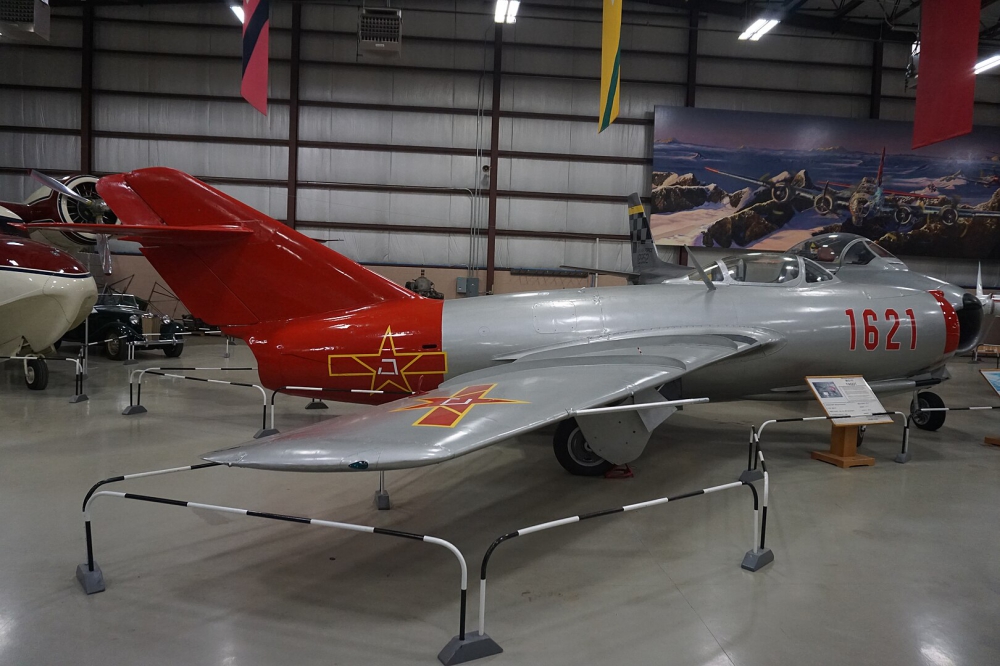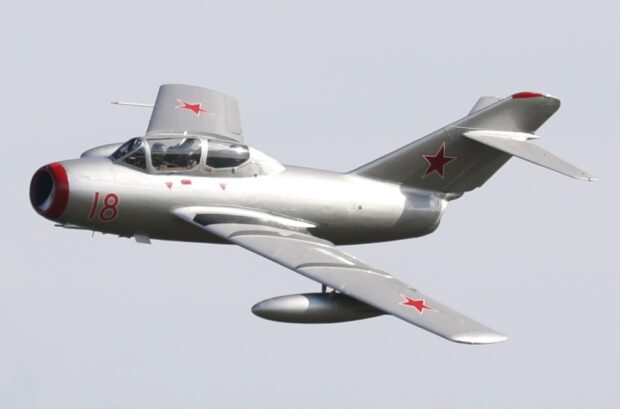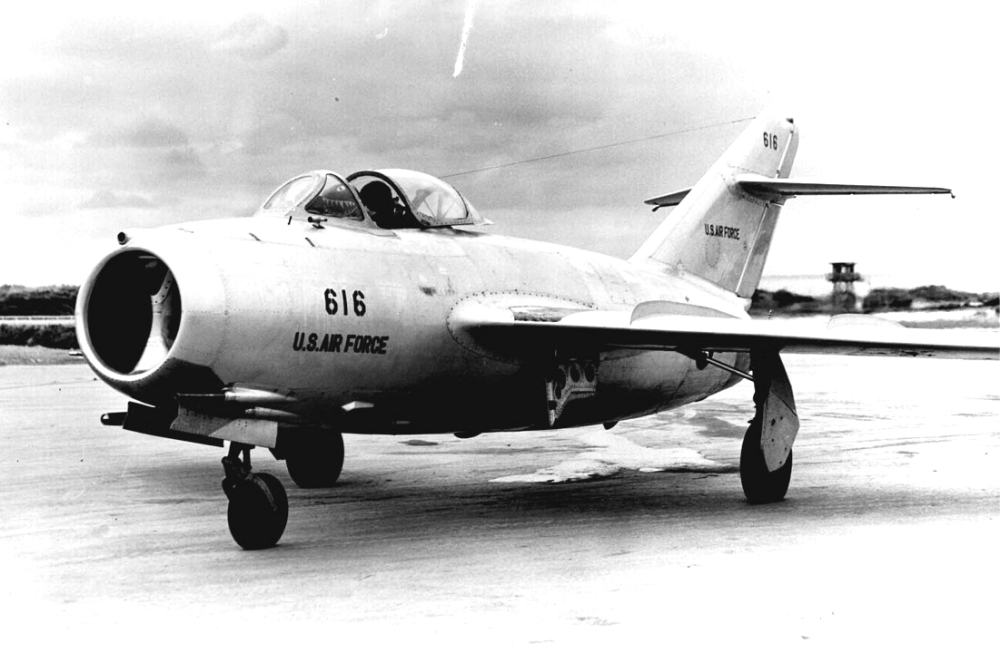It was November 1950. The Korean War was in full swing when a formation of B-29 Super fortresses made its way beyond the border to strike a hostile airbase. When the bombers sighted their target, one of the B-29s was suddenly struck by an explosion. The F-80 escorts reacted slowly and went after an unidentified aircraft.
Nevertheless, it promptly stripped away without difficulty and left the escorts puzzled and amazed by the speed, high operating altitude, and impressive climbing ability of the aircraft.
It was the first encounter of American aircraft with the USSR’s first fighter jet, the swept-wing MIG-15, an aircraft that took the US Air Force by surprise and quickly established air supremacy over the skies of Korea.
Developed as a bomber interceptor to end American bombing raids, the MIG-15 was so effective at tearing down warplanes that the US was forced to accelerate the development of the F-86 Sabre to reclaim air superiority again before the war in Korea ended.
The Mikoyan-Gurevich MiG-15 (Russian: Микоя́н и Гуре́вич МиГ-15; USAF/DoD designation: Type 14; NATO reporting name: Fagot) is a jet fighter aircraft developed by Mikoyan-Gurevich for the Soviet Union. The MiG-15 was one of the first successful jet fighters to incorporate swept wings to achieve high transonic speeds. In aerial combat during the Korean War, it outclassed straight-winged jet day fighters, which were largely relegated to ground-attack roles. In response to the MiG-15’s appearance and in order to counter it, the United States Air Force rushed the North American F-86 Sabre to Korea.
When refined into the more advanced MiG-17, the basic design would again surprise the West when it proved effective against supersonic fighters such as the Republic F-105 Thunderchief and McDonnell Douglas F-4 Phantom II in the Vietnam War of the 1960s.
The MiG-15 is believed to have been one of the most produced jet aircraft with more than 13,000 manufactured. The MiG-15 remains in service with the Korean People’s Army Air Force as an advanced trainer.
Design and development
The first turbojet fighter developed by Mikoyan-Gurevich OKB was the Mikoyan-Gurevich MiG-9, which appeared in the years immediately after World War II. It used a pair of reverse-engineered German BMW 003 engines. The MiG-9 was a troublesome design that suffered from weak, unreliable engines and control problems. Categorized as a first-generation jet fighter, it was designed with the straight-style wings common to piston-engined fighters.
The Germans had been unable to develop airworthy turbojets with thrust over 1,130 kilograms-force (11,100 N; 2,500 lbf) capable of running for more than a few hours at the time of the surrender in May 1945, which limited the performance of immediate Soviet postwar jet aircraft designs. The Soviet aviation minister Mikhail Khrunichev and aircraft designer A. S. Yakovlev suggested to Premier Joseph Stalin that the USSR buy the reliable, fully developed, Nene engines from Rolls-Royce (having been alerted to the fact that the U.K. Labour government wanted to improve post-war UK-Russia foreign relations) for the purpose of copying them in a minimum of time. Stalin is said to have replied, “What fool will sell us his secrets?”
However, he gave his consent to the proposal and Mikoyan, engine designer Vladimir Yakovlevich Klimov [ru], and others travelled to the United Kingdom to request the engines. To Stalin’s amazement, the British Labour government and its Minister of Trade, Sir Stafford Cripps, were perfectly willing to provide technical information and a license to manufacture the Rolls-Royce Nene. Sample engines were purchased and delivered with blueprints. Following evaluation and adaptation to Russian conditions, the windfall technology was tooled for mass-production as the Klimov RD-45 to be incorporated into the MiG-15.
To take advantage of the new engine, the Council of Ministers ordered the Mikoyan-Gurevich OKB to build two prototypes for an advanced high-altitude daytime interceptor to defend against bombers. It was to have a top speed of 1,000 kilometres per hour (620 mph) and a range of 1,200 kilometres (750 mi).

A Mikoyan-Gurevich MiG-15 on display at the Air Zoo at Kalamazoo/Battle Creek International Airport in Portage, Michigan (United States)
Designers at MiG’s OKB-155 started with the earlier MiG-9 jet fighter. The new fighter used Klimov’s British-derived engines, swept wings, and a tailpipe going all the way back to a swept tail. The German Me 262 was the first fighter fitted with an 18.5° wing sweep, but it was introduced merely to adjust the center of gravity of its heavy Junkers Jumo 004 pioneering axial-compressor turbojet engines. Further experience and research during World War II later established that swept wings would give better performance at transonic speeds. At the end of World War II, the Soviets seized many of the assets of Germany’s aircraft industry. The MiG team studied these plans, prototypes and documents, particularly swept-wing research and designs, even going so far as to produce a flying testbed in 1945 to investigate swept-wing design concepts as the piston-engined “pusher”-layout, MiG-8 Utka (Russian for “duck”, from its tail-first canard design). The swept wing later proved to have a decisive performance advantage over straight-winged jet fighters when it was introduced into combat over Korea.
The design that emerged had a mid-mounted 35-degree swept wing with a slight anhedral and a tailplane mounted up on the swept tail. Western analysts noted that it strongly resembled Kurt Tank’s Focke-Wulf Ta 183, a later design than the Me 262 that never progressed beyond the design stage. While the majority of Focke-Wulf engineers (in particular, Hans Multhopp, who led the Ta 183 development team) were captured by Western armies, the Soviets did capture plans and wind-tunnel models for the Ta 183. The MiG-15 bore a much stronger likeness to the Ta 183 than the American F-86 Sabre, which also incorporated German research. The MiG-15 does bear a resemblance in layout, sharing the high tailplane and nose-mounted intake, although the aircraft are different in structure, details, and proportions.
The MiG-15’s design understandably shared features and some appearance commonalities with the MiG design bureau’s own 1945–46 attempt at a Soviet-built version of the Messerschmitt Me 263 rocket fighter in the appearance of its fuselage. The new MiG retained the previous straight-winged MiG-9’s wing and tailplane placement while the F-86 employed a more conventional low-winged design. To prevent confusion during the height of combat the US painted their aircraft with bright stripes to distinguish them.
The resulting prototypes were designated I-310. The I-310 was a swept-wing fighter with 35-degree sweep in wings and tail, with two wing fences fitted to each wing to improve airflow over the wing. The design used a single Rolls-Royce Nene fed by a split-forward air intake. A duct carried intake air around the cockpit area and back together ahead of the engine. Its first flight was 30 December 1947, some two months after the American F-86 Sabre had first flown. It demonstrated exceptional performance, reaching 1,042 kilometres per hour (647 mph) at 3,000 metres (9,800 ft).
The Soviet Union’s first swept-wing jet fighter had been the underpowered Lavochkin La-160, which was otherwise more similar to the MiG-9. The Lavochkin La-168, which reached production as the Lavochkin La-15, used the same engine as the MiG but used a shoulder-mounted wing and t-tail; it was the main competitive design. Eventually, the MiG design was favoured for mass production.
Designated MiG-15, the first production example flew on 31 December 1948. It entered Soviet Air Force service in 1949 and subsequently received the NATO reporting name “Fagot”. Early production examples had a tendency to roll to the left or to the right due to manufacturing variances, so aerodynamic trimmers called “nozhi” (knives) were fitted to correct the problem, the knives being adjusted by ground crews until the aircraft flew correctly.
The MiG-15 was originally intended to intercept American bombers like the B-29. It was even evaluated in mock air-to-air combat trials with a captured U.S. B-29, as well as the later Soviet B-29 copy, the Tupolev Tu-4. To ensure the destruction of such large bombers, the MiG-15 carried autocannons: two 23 mm (0.91 in) with 80 rounds per gun and a single 37 mm (1.46 in) with 40 rounds. These weapons provided tremendous punch in the interceptor role, but their limited rate of fire and relatively low velocity made it more difficult to score hits against small and manoeuvrable enemy jet fighters in air-to-air combat. The 23 mm and 37 mm also had radically different ballistics, and some United Nations (UN) pilots in Korea had the unnerving experience of 23 mm shells passing over them while the 37 mm shells flew under. The cannon were fitted into a simple pack that could be winched out of the bottom of the nose for servicing and reloading, allowing pre-prepared packs to be rapidly swapped out. (Some sources mistakenly claim the pack was added in later models.)
The MiG-15’s simplicity, ruggedness, and particularly the absence of fuel tanks in its wings made it a formidable air-to-air adversary; its airframe has relatively few vulnerable areas, and shooting one down using the relatively fast-firing but less potent M2 Browning machine guns common in American aircraft almost invariably required multiple hits.
An improved variant, the MiG-15bis (“second”), entered service in early 1950 with a Klimov VK-1 engine, another version of the Nene with improved metallurgy over the RD-45, plus minor improvements and upgrades. Visible differences were a headlight in the air intake separator and horizontal upper edge airbrakes. The 23 mm cannon were placed more closely together in their undercarriage. Some “bis” aircraft also adopted under-wing hardpoints for unguided rocket launchers or 50–250 kg (110–550 lb) bombs. Fighter-bomber modifications were dubbed “IB”, “SD-21”, and “SD-5”. About 150 aircraft were upgraded to SD-21 specification during 1953–1954.
The MiG-15 arguably had sufficient power to dive at supersonic speeds, but the lack of an “all-flying” tail greatly diminished the pilot’s ability to control the aircraft as it approached Mach 1. As a result, pilots had to take care not to exceed Mach 0.92, where the flight surfaces became ineffective. The instrument panel had a red warning light that would illuminate when this speed was reached, and during post-Korean War flight tests, American test pilots found that the aircraft would buffet heavily above Mach 0.92 and would pitch up at Mach 0.95. During a high-altitude, full-power dive to determine the MiG’s top speed, Chuck Yeager reached Mach 0.98, but the aircraft would go no faster, and he lost roll control and did not begin to regain it until flying into denser air at 12,000 ft (3,700 m) of altitude; he had descended to 3,000 ft (910 m) by the time he fully regained control and recovered from the dive.
Additionally, the MiG-15 tended to spin after it stalled, and often the pilot could not recover. According to American test pilots, this behavior was exacerbated by the lack of a noticeable stall warning. The MiG’s proclivity towards sudden spins was deduced by UN pilots before the US was able to test one; during the Korean War, there were 56 recorded instances of UN pilots witnessing a MiG-15 entering a spin in combat, resulting in at least 25 crashes and ten ejections.
Top Photo: A Soviet Air Forces MiG-15UTI two-seater trainer over Duxford Air Festival 2017
Sources: Wikipedia; YouTube


